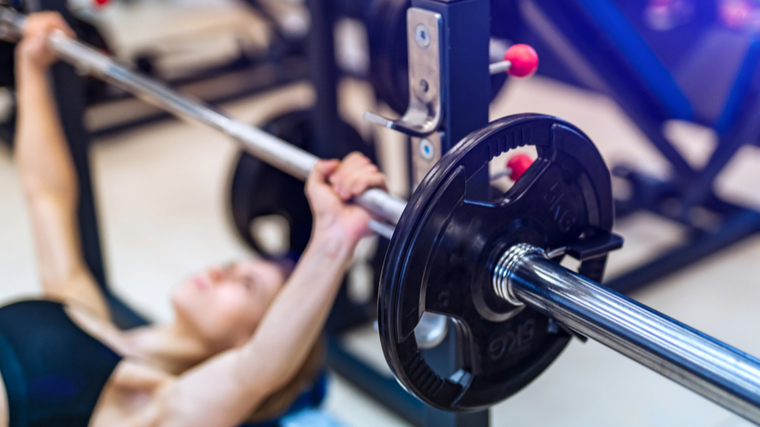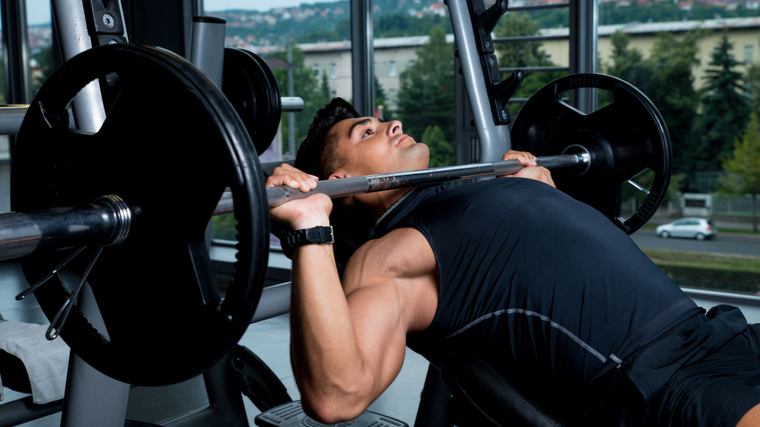If you are looking to build a bigger chest, specifically your upper pecs, look no further than the guillotine press. The guillotine press is a means of achieving serious upper chest development with a light weight. This exercise does pose some risks and challenges, so be sure to keep reading or learn more about the benefits, risks, and if it is the best option for you in your chest training.
The guillotine press is similar to the bench press, and can be done with a barbell or Smith machine. Unlike the standard flat bench press, the guillotine press has you press with the barbell on your clavicles instead of your chest, greatly increasing the tension applied across your pecs.
In this article, you’ll learn all about how to properly perform the guillotine press so that you can build bigger upper pecs.
- How to Do the Guillotine Press
- Benefits of the Guillotine Press
- Muscles Worked by the Guillotine Press
- Who Should Do the Guillotine Press
- Guillotine Press Sets and Reps
- Guillotine Press Variations
- Guillotine Press Alternatives
- Frequently Asked Questions
How to Do the Guillotine Press
The guillotine press can be done with a barbell or in a Smith machine, and is typically done on a flat bench. This exercise should be performed with slow eccentric movement, and taken as low as you can without pain or discomfort.
It must be stated that the guillotine press isn’t for everyone. If the exercise causes you stress or pain in your shoulders, drop the weight down immediately. If discomfort persists, consider opting for another means of training your upper chest. The guillotine press is equal parts effective and demanding.
Step 1 — Get Set Up

Start by setting yourself up like you would in a barbell bench press. Your feet should be planted on the floor, however you can also do this exercise with the feet up and minimal back arch to isolate the upper body even more. Grip the bar wider than you normally would, and ensure your shoulder blades are properly retracted.
Coach’s Tip: A wide grip will help you flare your elbows.
Step 2 — Unrack and Lower

Once you have unracked the weight, make sure your elbows stay flared out to the sides (rather than into the body). This may place extra strain on the shoulders in some cases, so if this is the case go light, or choose an alternative if you are in discomfort.
Coach’s Tip: Make sure to go slow and use zero momentum or bouncing in this movement. Stick to a starting weight that’s roughly 30% of your bench press max.
Step 3 — Pause, Then Press
Lower the barbell as low as you can while getting a good stretch on the upper pecs. The stretch should be felt in the middle of the upper chest. If you are feeling the stretch and discomfort in the front of your shoulders, make sure your elbows are flared and your shoulder blades are retracted. If you still do not feel the stretch, make sure you are slowly lowering the weight and pausing.
Once you have reached the bottom of the movement, press upwards, keeping the elbows flared.
Coach’s Tip: The key here should be getting a big stretch under load and maximizing time under tension. This will decrease the amount of weight you can use.
Benefits of the Guillotine Press
The guillotine press is a great upper chest developer that can be done without heavy loads. All you need is a barbell, some weights, and focus. This exercise is pretty specific to targeting the upper chest, and is not necessarily amazing for increasing strength or bench press performance.
With that said, it is vital that you do not go into this exercise with a mindset of progressing with heavy loads or pushing to failure. Ideally, this movement would be done with low loads, moderate to high reps, and very slow eccentrics.
Targets the Upper Pecs
The guillotine press targets the upper pecs since the bar is taken to the clavicles. Since it hits so high on the torso, your elbows need to stay flared. In doing so, you place a great stretch on the upper pecs. This depth to which you lower the bar should be taken only as far as you can control it, and not lose tension on the muscle.
A lot of people will try to shorten the range of motion and go heavier, however the load is the least effective factor in this movement. When looking to target the upper pecs with the Guillotine press, first aim to unlock the fullest range of motion with a 3 to 4-second eccentric phase and a pause in the bottom, then add load.
An Alternative to Incline Benching
In some instances, you may not have access to an incline bench to perform upper chest work on. If this is the case, you can use the guillotine press to help develop the upper chest muscle fibers. Unlike in the incline bench press, you should not lift heavy weights with the guillotine press, as this may result in shoulder impingement or injury.
Muscles Worked by the Guillotine Press
The guillotine press trains the upper pecs primarily, however, it will also provide some stimulus to your front delts. This movement should always be performed with slow lowering phases and no momentum. Below we will discuss in deeper detail which muscles are used during the guillotine press.
Pectorals
Your upper chest, or pectoralis minor, is the primary muscle targeted during the guillotine press. It is important that you focus on slow eccentric phases and move your barbell with control so that you keep tension on the upper pecs.
Anterior Deltoids
Your front delts are used in most pressing movements, regardless of the angle. During the guillotine press, sloppy technique can mean stimulating the delts over instead of your chest. The key is to not let the anterior deltoids take over the movement, which means using lighter loads, increasing the range of motion, and avoiding momentum during the lift.
Who Should Do the Guillotine Press
There’s a decent case to be made for most exercises insofar as they’re applicable to various populations. However, it must be stressed that the guillotine press is strictly used for increasing hypertrophy in the upper chest.
The Guillotine press has little strength-building potential and may add unnecessary stress to the shoulders for some weightlifters, powerlifters, or individuals who already have suspect shoulder integrity.
If you want to make upper chest growth a priority, have healthy shoulders, and can put your ego to the side, the guillotine press may be highly effective. However, it is far better to sub the movement out for incline pressing, wide-grip push-ups, or various flyes if you can’t make the guillotine fit your body.
Guillotine Press Sets and Reps
If you are looking to incorporate the guillotine press into your training program, it is important that you understand the purpose of the movement — to build chest size. Your programming must follow accordingly. Additionally, you should always use a spotter for safety.
Below you can find the most suitable programming guidelines for the guillotine press.
To Build Muscle Mass
The Guillotine press can be programmed very similarly to other isolation movements, and should be trained both in high rep and moderate rep ranges to build muscle mass. The key with this movement is to focus on a slow eccentric phase, often 3-5 seconds, and a slight pause at the bottom of the movement before pressing upwards without any reliance on bouncing the bar up or momentum.
Start by programming three to five sets of ten to 15 repetitions with light to moderate loads (20-40% of bench press max) or two to four sets of 15 to 25 repetitions, keeping rest periods of 45 to 90 seconds.
Guillotine Press Variations
The guillotine press is a great upper pec developer, and while it is often done with a barbell, it can also be done with a smith machine or dumbbells. If you find yourself without a barbell, or are looking to add some variety into your workout program, you can use these variations in the same manner.
Smith Machine Guillotine Press
The Smith machine guillotine press is performed identically to the standard barbell version. The only difference being that the fixed path of the Smith bar may help your stability and technique. This could possibly mean a better contraction on your chest, if you can find the right angle.
Dumbbell Guillotine Press
If you don’t have access to a barbell or a Smith machine, dumbbells can be a suitable tool for the guillotine press. The dumbbells might be more suitable if your shoulders aren’t perfectly symmetrical, although they lack the precise loading capability of a barbell.
Guillotine Press Alternatives
It’s possible that the guillotine press is simply not effective for your body type or training style. If that’s the case, these alternatives can be useful for developing your upper chest without requiring excessive shoulder mobility. As a secondary benefit, some of these lifts let you work with heavier weights.
Incline Bench Press
The barbell incline bench press is a great chest builder and strength movement. The incline targets the upper chest more than the flat bench press. If you use a wider grip on the incline bench press and a moderate to high incline, you can target the upper pecs to a high degree without the added injury risks of the guillotine press.
Wide Grip Incline Push-Up
The wide grip push-up already places more stretch on the chest fibers than the standard push-up, and throwing in the incline helps to further enhance this benefit. Like the guillotine press, the wide grip incline push-up targets the upper pecs, and can be done with your elbows more flared to further isolate the upper chest muscle fibers.
Incline Flye
The incline dumbbell or cable flye is a great chest isolation exercise that can be done to increase upper chest development without adding high amounts of risk or stress to the shoulders. Like the guillotine press, the incline flye should be done with light to moderate loads, slow eccentric phases, and a big stretch at the bottom to maximize muscle growth.
Final Word
Some exercises are suitable for every athlete — some take a bit of finesse to utilize properly. If you’re after more size or width on your upper pecs, the guillotine press can be extremely beneficial. However, if you’ve got pre-existing issues or prefer to go heavy in the gym, there are likely better options.
Part of being a mature gymgoer is identifying what works for you, and what doesn’t. Don’t force the issue when it comes to including exercises if they don’t jive well with you. That said, the guillotine press earns high marks for building a truly impressive pec shelf.
FAQs
For an exercise as specific as the guillotine press, you undoubtedly have some nagging questions. Let’s look at two common ones.
Who should not perform the guillotine press?
If you’ve suffered some shoulder injuries in the past or have limited flexibility in your shoulders — particularly low internal rotation — the guillotine press might not be for you. It may be wise to master some of the alternatives to the guillotine press before moving onto the lift itself.
How heavy should you train the guillotine press?
The Guillotine press should be performed with lighter loads. The exact amount of loading can vary, however generally speaking this movement should be performed with no more than 40% of one’s bench press max, often even lighter. Muscle damage and stress should be produced via increased time under tension (slower rep speeds), longer eccentric phases, increased ranges of motion, and higher reps.
Featured Image: Jasminko Ibrakovic / Shutterstock
